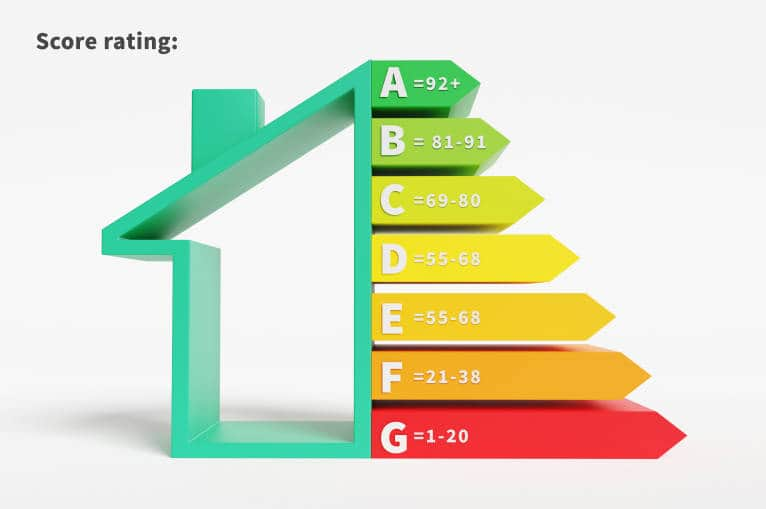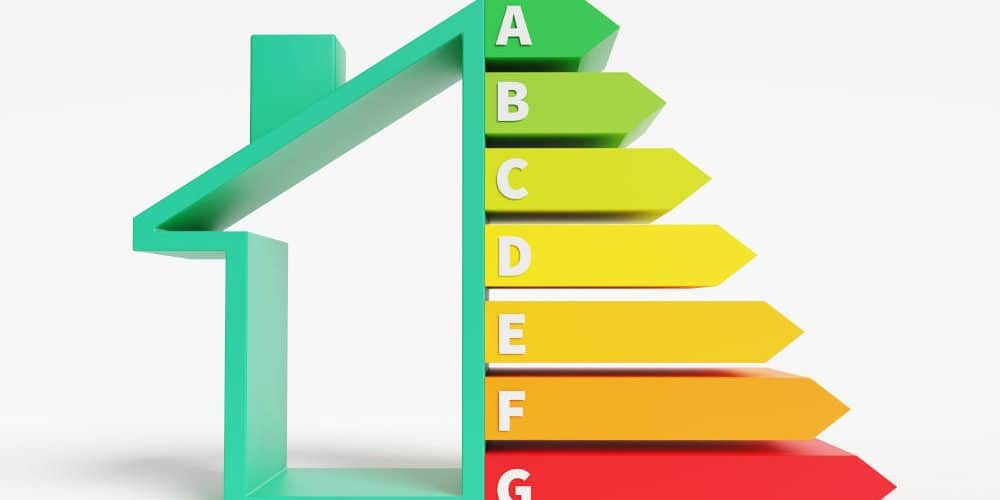Find out more about Energy Performance Certificates (EPCs) and ratings, how much they cost and how to get one.
What Are EPC Ratings?
EPC ratings stand for Energy Performance Certificate ratings. They are used to assess the energy efficiency of buildings in the UK. The Energy Performance Certificate (EPC) are like those vibrant stickers adorning brand-new appliances. If you've recently purchased a sleek washing machine, a shiny dishwasher, or a state-of-the-art boiler, chances are you've crossed paths with one. Ratings are given on a scale from A to G, with A being the most energy efficient and G being the least.
In the UK, an EPC is required by law when a building is sold, rented, or constructed, helping to inform potential buyers or tenants about the energy efficiency of the property. An EPC rating considers factors such as insulation, heating systems, and renewable energy sources to determine how energy efficient a building is.
They also provide valuable information about a property’s energy use and how much it is likely to cost over the next three years. It also suggests ways to reduce energy use to save money.
Traditionally, it was often assumed that newer homes boast superior EPC ratings compared to their older counterparts. However, nowadays, homeowners are rewriting the rulebook. With a surge of enthusiasm alongside the global efforts to reach Net Zero, many are breathing new life into their older, more traditional homes, embarking on energy-efficient makeovers that propel them up the EPC rating scale.
Where Did EPCs Originate?
Energy Performance Certificates (EPCs) originated from the European Union's Energy Performance of Buildings Directive (EPBD), which was first adopted in 2002. The EPBD aimed to improve the energy efficiency of buildings across EU member states to reduce energy consumption and carbon emissions. As part of this directive, EPCs were introduced as a way to assess and communicate the energy efficiency of buildings to occupants, buyers, and renters.
The UK implemented EPCs in 2007 as a requirement for most residential and commercial buildings when they are constructed, sold, or rented out. EPC ratings, ranging from A to G, provide an indication of a building's energy efficiency and recommendations for improving it. They have since become a standard tool for evaluating and improving the energy performance of buildings, not just in the UK but also in various other countries influenced by similar EU directives.
What Does An EPC Consist Of?
The look of an Energy Performance Certificate may vary slightly depending on where they were issued and whether they are for a property in England, Scotland, Wales, or Northern Ireland. However, they all contain the same key information:
Property Details
- Address: The full address of the property being assessed.
- Property type: Whether it is a house, flat, or other type of building.
- Construction date: The year the property was built.
Energy Usage
- Estimated energy costs: Annual energy costs for a three-year period including heating, hot water, lighting, and ventilation. If you are looking at a property with the intention of buying it, always ask to see the EPC before making your offer. Likewise, if you are wanting to rent a property, an EPC will give you an idea of how much your bills could be. Be aware that EPCs do not cover the typical costs for appliances such as washing machines, tumble dryers, TVs, ovens, and fridges.
- Recommendations: Suggestions for improving energy efficiency and reducing costs.
Assessor Details
- Accreditation: Information about the assessor's accreditation scheme and registration number.
- Date of assessment: The date when the assessment was carried out.
Graphs And Visuals
- Graphical representations: Visual aids illustrating energy efficiency ratings and potential cost savings from recommended improvements.
EPC Rating
- Current energy efficiency rating: Presented on a scale from A (most efficient) to G (least efficient).
- Environmental impact rating: Also graded from A to G, reflecting the property's carbon dioxide emissions.
Property Features
- Heating system: Details about the type of heating system installed (e.g. gas boiler, electric heating).
- Insulation: Information on the insulation present in the property, including walls, roof, and floors.
- Windows and doors: Description of the glazing type (single, double, or triple glazed) and materials used.
- Ventilation: Overview of ventilation systems, if any, and their efficiency.
- Renewable energy sources: If applicable, details about any renewable energy technologies installed (e.g. solar panels, heat pumps).
Validity Period
- EPC expiry date: The date until which the certificate remains valid (typically 10 years).
Additional Information
- Energy performance indicators: Specific metrics used to calculate the energy efficiency and environmental impact ratings.
- CO2 emissions: Estimated carbon dioxide emissions associated with the property's energy usage.
In short, an EPC serves as a comprehensive snapshot of a property's energy performance, providing valuable insights for homeowners, tenants, and prospective buyers on ways to improve efficiency and reduce environmental impact.
House Energy Efficiency Ratings
An EPC will always provide a visual of the property’s current energy performance rating. As mentioned earlier, you will recognise the rating from those cheerful stickers adorning your trusty home appliances. Each performance level, from the extremely efficient A to the less-than-stellar G, is represented by a colour and a corresponding score out of 100, elegantly displayed in a bar chart to paint a clear picture of your home’s efficiency journey. It is a clear snapshot of your home’s energy health.
As well as the current rating, the property’s potential EPC rating is also indicated on the chart. This helps you see what rating you could achieve if you carried out suggested improvements.
So, when you lay eyes on that colourful chart, remember—it is not just about where you are, but where you are headed. With each improvement, you are not just saving energy; you're crafting a more efficient future for your home.

According to Gov.uk, the average energy efficiency rating for a property in England and Wales is band D (rating 60).
EPC A Rating vs EPC Rating G
As we outlined earlier, an EPC rating of A indicates that a home is exceptionally energy-efficient and environmentally friendly, while a home with an EPC rating of G represents the lowest level of energy efficiency, indicating significant energy wastage and high environmental impact. But you might be wondering, what sets apart a home with an A rating from one scraping the bottom with a G?
The following comparison table sheds some light on the subject:
| Aspect | EPC Rating: A | EPC Rating: G |
| Insulation | Top-tier insulation in walls, roofs, and floors, minimising heat loss year-round. | Poor insulation leads to significant thermal losses, increasing energy consumption for heating. |
| Heating System | Sophisticated array of modern heating solutions, ensuring optimal warmth efficiently. This could include a condensing boiler, underfloor heating, or a heat pump, which ensures optimal warmth while prudently managing energy consumption. | Outdated or inefficient heating systems, such as old gas or electric heaters, which consume excessive energy to maintain warmth. These systems are often inefficient at converting fuel or electricity into usable heat. |
| Glazing | High-performance, double, or triple-glazed windows and doors, maintaining consistent temperatures. | Single glazed or poor-quality windows, allowing heat to escape easily. |
| Lighting | LED illumination with minimal energy expenditure, demonstrating a commitment to efficiency. | Traditional, energy-intensive lighting, contributing to higher electricity usage. |
| Renewable Integration | Potential integration of renewable energy technologies, such as solar energy through photovoltaic panels, to generate clean electricity on-site, reducing reliance on grid energy. | Lack of renewable energy technologies, leading to higher carbon emissions. |
| Ventilation | Efficient ventilation systems ensuring good indoor air quality and minimal heat loss. | Inadequate ventilation leading to stagnant air and increased energy consumption. |
| Appliances | Energy-efficient appliances throughout, contributing to overall energy savings. | Outdated, energy-intensive appliances, increasing energy consumption and costs. |
In short, achieving an A-rated EPC requires a holistic approach to energy efficiency, combining superior building materials, advanced technologies, and sustainable design principles. Homes with this rating not only provide exceptional comfort and savings for occupants but also contribute positively to the environment by reducing carbon emissions. On the opposing scale, achieving a G-rated EPC reflects a lack of energy-saving measures and outdated building practices. Homes with this rating typically require significant improvements to enhance energy efficiency, reduce energy bills, and minimise their environmental footprint.
Why Get An EPC?
If you are looking to sell or rent out your home, you will need an EPC. It is a legal requirement, and you could risk a fine if you do not ensure you have an EPC available to potential buyers or renters before you start marketing your property.
On the other hand, if you are looking to buy or rent a property, the EPC lets you compare the energy efficiency of different properties easily.
Whilst the EPC rating should be considered when deciding whether to buy a property, remember that the EPC also gives recommendations on how to improve your rating which could be a fantastic way to add value.
If you make any of the energy efficiency recommendations detailed in your EPC, you may want to get a new EPC to factor in these improvements and update your official rating.
An EPC is valid for 10 years.
How To Get An EPC Certificate
It is completely free to check if a property has a valid EPC, so it is always worth checking first to save time in requesting one unnecessarily.
However, if you do need a new EPC, you will need to get an approved domestic energy assessor to produce it for you.
Cost Of An Energy Performance Certificate
There is no one-size-fits-all price for an Energy Performance Certificate. The cost of an EPC will vary by assessor, as well as the size, type and location of the property being assessed. As a guide, according to hoa.org.uk, the average price of obtaining an Energy Performance Certificate lies between £60 and £120. The EPC assessment itself, tends to take about an hour but again, this will depend on the property size.
The next time you see that rainbow-colored sticker on a building, remember—it is not just a rating; it is a symbol of a brighter, more sustainable future we're building, one energy-efficient home at a time.
Don't forget, if you are looking to bump up your home’s rating by investing in a new, energy efficient boiler or other appliance, or maybe you need some advice on heat pumps vs gas boilers, the team at Maintracts Services can help you get off to a great start.
All our plumbers and heating engineers are fully qualified, super professional and full to the brim with knowledge and experience. Contact us at your convenience to chat through your requirements. Additionally, we offer general electrical services to meet all your needs. Contact us at your convenience to discuss your requirements!

